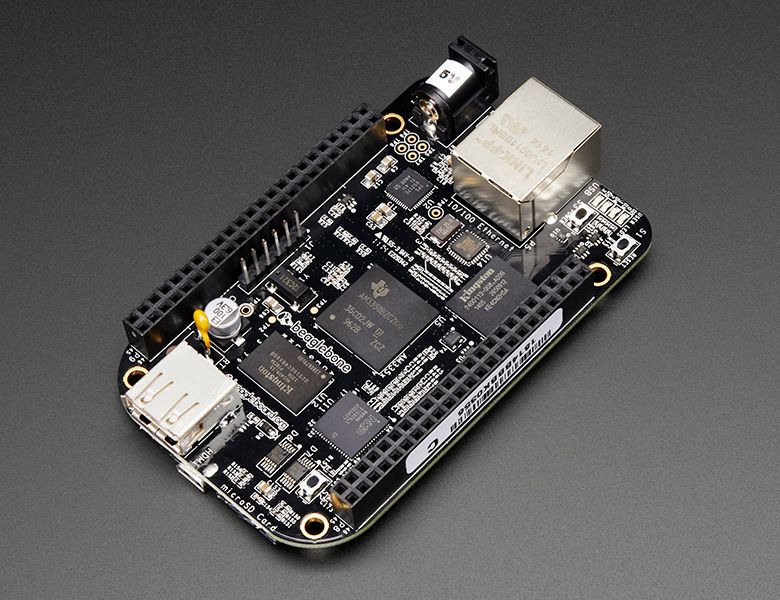
BeagleBone Black by BeagleBoard
If you liked the BeagleBone Black Rev B, you will love the Rev C! The Rev C has a blistering 1GHz AM3358 processor and 512MB onboard DDR3 RAM, two 46-pin headers, micro HDMI for audio/video output, USB ports, 10/100 Ethernet and other I/O features. The Rev C is an ultra-powered embedded computer that can fit in a mint tin.
This model includes 4GB of eMMC built-in storage instead of the Rev B’s 2GB. With the doubled storage and faster eMMC, the developers were able to make the Rev C’s most significant change: shipping the BeagleBone Black with Debian Linux pre-loaded on the board’s flash instead of Angstrom Linux. Debian Linux is a more user-friendly operating system than Angstrom and the switch to Debian is partly the result of consumer demand (especially from Adafruit users, thanks!)
Of course the BeagleBone Black Rev C is an open board so if you want to load it back up with Angstrom or other Linux-based distributions like Ubuntu or Android, you can.
The rev C comes with a mini-B cable for powering it up ASAP. No microSD card is included as the BBB has onboard flash storage - and no SD card loading is required to get started. Please note the PCB may say rev B, that’s normal! The rev C has more memory which did not affect the PCB revision code.
- Processor: Sitara AM3358BZCZ100 1GHz, 2000 MIPS
- Graphics Engine: SGX530 3D, 20M Polygons/S
- SDRAM Memory: 512MB DDR3L 606MHZ
- Onboard Flash: 4GB, 8bit Embedded MMC
- PMIC: TPS65217C PMIC regulator and one additional LDO.
- Debug Support: Optional Onboard 20-pin CTI JTAG, Serial Header
- Power Source: miniUSB USB or DC Jack, 5VDC External Via Expansion Header
- PCB: 86.44mm x 54.54mm / 3.4” x 2.15” 6 layers
- 88.98mm x 54.54mm x 15.41mm / 3.5” x 2.15” x 0.6”
- Indicators 1-Power, 2-Ethernet, 4-User Controllable LEDs
- HiSpeed USB 2.0 Client Port: Access to USB0, Client mode via miniUSB
- HiSpeed USB 2.0 Host Port Access to USB1, Type A Socket, 500mA LS/FS/HS
- Serial Port UART0 access via 6 pin 3.3V TTL Header. Header is populated
- Ethernet 10/100, RJ45
- SD/MMC Connector microSD , 3.3V
- User Input: Reset Button, Boot Button, Power Button
- Video Out: 16b HDMI, 1280x1024 (MAX), 1024x768,1280x720,1440x900 w/EDID Support
- Audio Via HDMI Interface, Stereo
- Expansion Connectors:
- Power 5V, 3.3V , VDD_ADC(1.8V)
- 3.3V I/O on all signals
- McASP0, SPI1, I2C, GPIO(65), LCD, GPMC, MMC1, MMC2, 7 AIN(1.8V MAX), 4 Timers, 3 Serial Ports, CAN0, EHRPWM(0,2),XDMA Interrupt, Power button, Expansion Board ID (Up to 4 can be stacked)
- Weight 40.55g / 1.43oz
Purchase
Contribute
Have some info to add for this board? Edit the source for this page here.
Adafruit Blinka Installation
We use a special library called adafruit_blinka (named after Blinka, the CircuitPython mascot) to provide the layer that translates the CircuitPython hardware API to whatever library the Linux board provides.
For example, on Raspberry Pi we use the python RPi.GPIO library. For any I2C interfacing we'll use ioctl messages to the /dev/i2c device. For SPI we'll use the spidev python library, etc. These details don't matter so much because they all happen underneath the adafruit_blinka layer.
